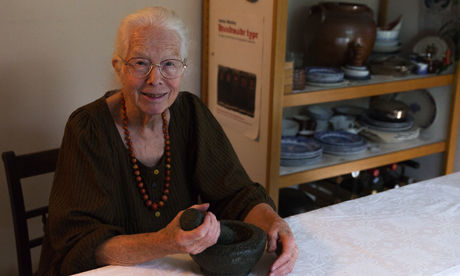Time is nigh for high Gothic feasting, says food historian Gillian Riley

Food historian Gillian Riley. Photograph: Eleonore de Bonneval
The autumnal delights of Hackney are an inspiration, from the farmers’ markets to the fresh produce in all the small food stores.
Perhaps the medlar fruits are a bit of a puzzle, needing to be on the way to rotten to give up their full flavour.
But the quinces, fragrant English ones appearing about now, and then the Turkish ayva which will be along soon, and well into the new year, are a source of so many different recipes, from quince vodka (grated with sugar and vodka and hidden away in a dark place to mature) to a hearty Renaissance vegetarian dish of chickpeas and ribbon pasta baked with quinces stewed in butter and spices.
My enthusiasm for cooking began a long time ago.
Travelling in Italy in search of inscriptional lettering took me and my husband off the tourist tracks and to places where honest local food was to be found. (This was long before gastro-tourism, before the ‘discovery’ of Italy by every food writer in the land).
And so from quiet corners in Rome, back streets in Florence, bars in Venice and under the sheltering arcades of Bologna came whiffs of unimaginable dishes, delicious beyond belief.
I had to find out more about them. I was pig ignorant.
From quiet corners in Rome and back streets in Florence came whiffs of unimaginable dishes
Looking back that was how the book I authored, The Oxford Companion to Italian Food, began; it grew out of my need to know more about this amazing and wonderful cuisine.
Research led me from food markets teeming with produce to libraries rich in manuscripts and early printed books and on to homes and restaurant kitchens where my greed and curiosity were handled with generosity and forbearance.
Hackney today has some of this generosity. You can ask in Turkish stores how to cook unfamiliar products or how to stuff vine leaves.
A kind next-door neighbour offers tastes of her cooking, lentil soup and paper-thin flatbread.
Mangal II becomes a refuge on cold winter days.
I once met someone who no longer lived in these parts and was nostalgic for the “smells of Church Street”, the aromas of different cuisines, the spices in the air and now the whiffs of coffee and freshly-baked bread.
When I first moved here I was captivated by the message to us Brits from an elderly Italian exiled in Jacobean London who expounded the virtues of fruit and vegetables.
His exhortations are as timely today as it was in 1612.
He wrote a comprehensive, entertaining description of all the herbs, fruit and vegetables to be had in Italy, hoping to convert us to healthier living and the delights, not of vegetarianism, but of simple fresh salads and vegetables.
What better place than Hackney to pursue this theme?
As I struggled to translate the text and reproduce Giacomo Castelvetro’s tone of voice, I could forage in local shops, finding the purslane, mallow, medlars and quinces, rocket and sorrel, the pekmez (condensed grape must) and pine nuts, the quince paste and apricot leather, long before that daft myth of the (non-existent) ‘Mediterranean cuisine’ was swallowed by credulous journalists.
That was decades ago, but Hackney already had the message, and Castelvetro’s text had special relevance in such a congenial environment.
When cooking the recipe below I source the fruit and veg from brilliant greengrocer Stoke Newington Fruit and Vegetables, situated opposite Whole Foods in Church Street.
The meat is from Meat N16, a wonderful shop offering fresh produce at competitive prices.
The dish is from the early fourteenth century and was cooked in Venice and Genoa but was heavily influenced by Persian cooking and flavours from the Middle East made popular in Italy because of the spice trade.
Its strange name, Romania, is derived from the Arabic word for a royal recipe, ‘rummaniya’, using pomegranate juice.
You can buy condensed pomegranate syrup in many Hackney groceries to give a spiced chicken dish a rich sweet/sour fruitiness, and the flavour will transport you back in time to an age of high Gothic feasting.

Romania – Medieval Chicken with Pomegranate. Photograph: Eleonore de Bonneval
Romania – Medieval Chicken with Pomegranate
Serves four
Six chicken joints (thigh and breast)
Four rashers fatty unsmoked bacon, diced
One medium onion, chopped
One clove garlic, chopped
Two pomegranates, the seeds squeezed and strained
Sugar to taste
Spice mixture: one stick (3cm) cinnamon, six peppercorns, six cloves, one tsp fennel seeds, one tsp coriander seeds, ¼ nutmeg, four cardamom pods, ground together in a pestle and mortar or spice grinder
Water if needed
Almonds, unskinned, ground
Rosewater
Fry the chicken joints with the onion, bacon and garlic in a little olive oil until golden. Add the spices to taste and stir well. Then pour in the pomegranate juice and taste; if needed add some sugar, you want a fruity sweet/sour effect.
Top up with just enough water to cover, and simmer gently until the chicken is cooked and there is not too much liquid. Thicken this with the ground almonds and cook a little longer.
Just before serving sprinkle on a little rose water and some more of the spices.
Related:
Food historian Gillian Riley shows how to dine like a 15th century gastronome
